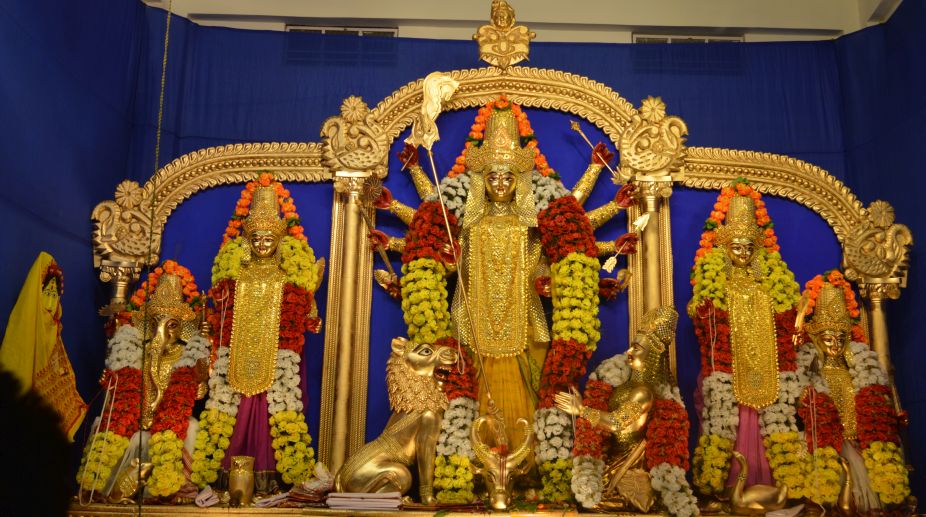Hindu mythology talks at length of muppathu mukkodi thevargal, the innumerable celestial beings who rule all the worlds. Each god is blessed with a vehicle bird, beast, rodent and even reptile. Brahma, the creator, and his consort Saraswati, goddess of knowledge and wisdom, use a celestial bird called Hamsa as their vehicle. This bird is neither a swan nor a duck nor a goose nor a pheasant nor a peafowl. It is a perfect mixture of all these and yet is not attached to any of them. It is a strange bird that neither belongs to the earth nor the water nor the sky. But it has the wisdom to separate water from milk. The next in the Trinity is Vishnu. If Brahma is the creator, then Vishnu is the preserver of life and his vehicle is Garuda. This bird is a copper-coloured eagle with a white head, neck and breast. Brahminy kite is another name given to this bird. Laksmi, Vishnus wife, has an owl for a vehicle. While the first two lords and their consorts like to have birds as their vehicles, the third in the Trinity, Shiva and his wife Parvati prefer animals to birds. Bull, also known as Nandi, is Shivas vehicle and Parvati loves to ride a lion. Of their two sons, Ganesh, the elder, has a mouse for his vehicle but Subramanya or Karthick, the younger, travels on a peacock. On the other hand, Yama, the Lord of Death, uses a buffalo. The rain-god Indra parades the heaven and the earth on his elephant. Ayyappa, the net result of the physical union between Lords Shiva and Vishnu, roams the mountains and the forests on a ferocious tiger. It is not without any significance that these special vehicles are assigned to the gods. These privileged vehicles represent the power and energy of the gods and goddesses they carry. Perhaps this is the reason why Hindus worship birds and animals. These vehicles hold testimony to the proverb, Love me love my dog and it is true of snake worship too. A hooded snake is always found in a coiled position on the neck of Shiva and Lord Vishnu rests on the multi-headed cosmic serpent Anantha. Of all the vehicles of the gods, the owl takes the cake. It is blessed with enormous eyes that can see well in even the faintest of light. Its ears can hear the faintest of sounds even the distant sound of a squeaking mouse. It can fly silently for its wing feathers are very soft. And once its prey is at sight, the owl grabs it with both feet, killing it instantly. Then it swallows the food whole. If the owl is not an apt symbol for an active scholar, where is the symbol to be found for the scholar then? Its small wonder that Lakshmi, the goddess of wealth and prosperity, has an owl for a vehicle apart from an elephant. Perhaps she uses the elephant while travelling on land, and the owl for her visits to the sky. Lakshmi is an Indian counterpart of the goddess Minerva of Roman mythology and goddess Athena of Greek mythology. All the three goddesses, associated with wisdom, have owls for their vehicles. In North American Indian (Pimas) mythology, the owl is a symbol of the souls of the dead. Like the Pimas, we Indians too believe that if an owl happens to be hooting at the time of death, it is certain that the owl is waiting for the soul of the dying person it is the luring cry of Yama, Lord of Death. The Egyptian hieroglyph for owl symbolises death, night, cold and passivity. In medieval Christian folklore the owl was seen as a demonic force and its presence an ill-omen. Folklore has it that owl feathers are rushed to the dying person to help him/her reach the other world with little or no difficulty. Heres another interesting tale. Once Jesus, in disguise, walked into a bakers shop and begged for bread. The mistress of the shop took pity on the poor hungry man and immediately put some dough in the oven. Her daughter considering that too much, reduced the quantity to half. Not satisfied with her own action, she went again to the oven and further reduced the dough. But a miracle happened. The dough began to rise and rise in the oven, pushing open the doors and falling across the floor. The sight made the stingy girl cry, heugh, heugh, heugh. Jesus who heard her cry like an owl turned her into one. In Hamlet, William Shakespeare makes Ophelia answer King Claudiuss question How do you, pretty lady? with Well, God, ild you! They say the owl was a bakers daughter. Lord, we know what we are, but know not what we may be. God be at your table! Wasnt Shakespeare familiar with the British folktale? Despite all the medieval bias that identified the owl with ill omen, numerous motifs associated with it abound in world literature. But for its association of wisdom and prosperity, Goddess Lakshmi would not have chosen this nocturnal bird of prey with large eyes and a broad head as her vehicle. The fact that the goddess has treated the bird on a par with an elephant (another vehicle of Lakshmi) is quite remarkable.
Vehicles of the gods

(Getty Images)





